I am pretty sure this is the reason I took a vacation from foldables in the first place...I had no idea what the best way to have the kids store them.
We are making out okay currently by copying a sheet with a header on it and having the kids glue the foldable to it. From there, they add the page to their 3 ring binder with the rest of their math stuff.
I MIGHT (notice the emphasis on 'might') have come up with a solution for random, vulnerable foldables for the future. I am trying it out with the students I am tutoring before and after school. Rather than adding the foldables to a sheet of paper, we are gluing/taping them into a composition book, hence creating a customized, unique math textbook that can be used as a reference for this year and beyond. I wish I had thought of it earlier, but now I have the time to try it out with tutoring and hopefully identify any glitches prior to implementing the idea with close to 100 kids.
Any thoughts are welcome.
Monday, March 26, 2012
Area of a Trapezoid
First and foremost, let me apologize for the extremely poor quality of these photos.
Covered this with my students moving up to Algebra next year. We don't cover the area of a trapezoid in 6th grade.
As usual, I wanted them to understand the 'why' behind the formula.
We simply took a sheet of paper and hamburger folded it, ripped it, and shared with our neighbor (each student only needs 1/2 a sheet of paper). from there we folded it in half again, hamburger style. Then, we cut some off of the left and right sides to create a trapezoid from the rectangle.
To show that the formula of a trapezoid is 1/2 the height multiplied by the two base lengths added together, we folded the top layer of the trapezoid so that the front showed 1/2 the height. We glued it such that the portion of the trapezoid we cut off matched up with the 'flap' created from the fold.
{unfolded}

{folded up}

squares--perfect or not!
I am in the process of tutoring several students who will be going straight from my 6th grade advanced class to 7th grade Algebra. There are quite a few concepts and skills they will miss if I do not cover them outside of the regular class curriculum, so their parents have been gracious enough to allow me to work with them before school.
One of the concepts I need to cover is Pythagorean Theorem (which I'm really excited about because I was missing it from the 8th grade curriculum). Before I could just jump into good 'ole Pythagoras, I needed to introduce the concept of non-perfect squares, as all I am required to cover in the 6th grade curriculum is the concept of perfect squares.
As I often like to do, I wanted to start with what they knew, and build on that.


pi, good ole pi!
Remember when I said earlier that there can be a lot of pressure associated with being the 1st to teach something to the kids. I found the concept of PI to be the perfect example. Pi is a difficult concept for most adults to wrap their heads around, much less students, and 10-12 year old students at that. My PLC partner and I must have grappled with the concept of pi for an hour one day, going back and forth about is pi a rational number since it's the ratio of the circumference of a circle and that circle's diameter, yet when you look at the numbers they appear to be irrational. Then we got into how pi is really the ratio of two measurements, which forces it to always be an approximation because measurements are always approximations. whew. All of this as we were trying to figure out how to present the concept of PI to students who have limited ratio, proportion, geometry and measurement knowledge.
We tried very hard to choreograph the perfect dance of accurate knowledge without completely blowing their minds!
here is the foldable I came up with in an effort to do just that:
{front}

Just like any other math teacher, I am very hesitate to attach a number with pi, I much prefer to refer to it as the ratio of circumference to diameter (there is a hilarious segment of a stand up on pi that my PLC partner sent me that acknowledges the face that math teachers refuse to refer to pi as anything other than the ratio :-) but that's a post for another time). Okay, back to the point...sorry...I wanted to emphasize the ratio, so I typed up the ratio in fraction notation and made the fraction bar really thick so it wouldn't get overlooked. The kids were responsible for folding the paper in half (hot dog style) and then cutting on the thick fraction bar. I fit 4 of these to a page, so it was a real paper saver, for once. Notice, I also put the pi symbol as a watermark on the front. I created this foldable using ActivInspire software as well as Microsoft Word.
{inside}

The ratios on the right of the foldable (535/170 and 526/168) are both data from a Twizzler activity my PLC partner put together which allowed the students to discover the ratio of circumference to diameter of the same circle. I was trying to point out that neither of these are 'perfectly pi' because they are measurements, but they are close to pi. We also discussed as a class that the more accurate your measurements, the closer your number should be to pi.
Cylinders
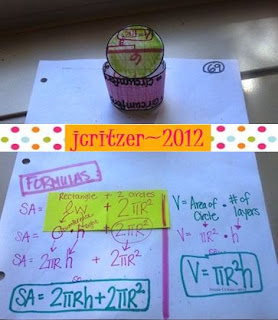 Along the same lines as surface area and volume of rectangular prisms, I went with the net approach for the surface area and volume of cylinders. I think it really allowed the students to see the connection between the circumference and the length of the rectangle as well as the connection between the height and the width being the same distance.
Along the same lines as surface area and volume of rectangular prisms, I went with the net approach for the surface area and volume of cylinders. I think it really allowed the students to see the connection between the circumference and the length of the rectangle as well as the connection between the height and the width being the same distance.
{what you cannot see here is the 2nd circle, which has been taped down to the note page. Before we developed the formula, we talked about the cylinder being made of two circles and a rectangle. To develop the surface area formula we talked about need the area formula for a circle twice as there are two circles and then the area of the rectangle, which could be obtained from the circumference multiplied by the height}

Similar to the discovery of the volume of a rectangular prism being the area of the top multiplied by the number of 'layers,' the students discovered that the volume of a cylinder is simply the area of the circle multiplied by the number of 'layers.'
Rectangular Prisms
It seems with every year, you get better and better. Well, one would hope, I guess. I have had the unique opportunity to 'learn all over again' by teaching 6th grade this year. I often am reminded that these kiddos are learning things for the first time and I get to be the one to introduce concepts and skills. As fun as is it, it is also an incredible amount of pressure. I want to be sure I am providing accurate and sound information and on top of that, I want it to make sense to them.
As we talk about formulas, it is important to me that they know WHY the formulas are what they are; I don't just want them to accept them without knowing why. I must have said, "I could have just given you these formulas and said, 'have at it,' but I want you to understand WHY!"
I have never presented the surface area and volume of rectangular prisms in this way, but I think it really paid off.
Here is how we started. I gave them a blank net and asked them what they noticed. Most quickly discovered that there were pairs of rectangles that were the 'same.' We solidified our understanding by clarifying that the areas of the rectangles were the same. I asked them to color code the rectangles so that the same colors had the same area. From there we labeled the rectangles with the exact areas.

I asked the students how they determined the areas of each of these rectangles, which lead us into the conversation regarding the dimensions. Because this is a 2D picture of a 3D object, at first we only labeled all lengths and widths. Before we could completely defend our areas measuring 8 square units, we cut out the net and folded it to create the rectangular prism. We did not tape or glue it together as we would eventually glue it down to our note sheet and didn't want to ruin it trying to un-tape it.
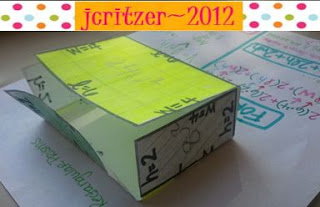
It was at this point, we could start talking about the previously missing dimension~height. The students were now able to defend their areas of 8 square units because they saw that the height of the 'box' was 2 units.
So, this is the part that I did differently from years past. If you look closely, you can see that I started off the derivation of the formula with the numbers from the example, then I showed which dimension each represented, and from there we derived the formula. Now, I'm sure it didn't take the rest of you 10 years of teaching to figure out that was the way to go, but it did me...I need help...but we've already established that :-)

The kiddos picked up the fact that the volume of a rectangular prism was the area of the top (length times width) multiplied by the number of layers (the height). I can't say they discovered this from the net, but rather a 'do now' activity that my amazing PLC partner created.
The kids simply flattened out the net when it was time for them to place in their binders. It was important to me that they had the capability of folding it flat to see the net as well as the capability of folding it up to see the rectangular prism.
Friday, March 23, 2012
Dimensions&Shapes
This week we began our discussion of 3D figures~rectangular prisms and cylinders. Before jumping in, I felt like I needed to address the differences in 1D, 2D, and 3D. This is a short do now I created as an introduction.
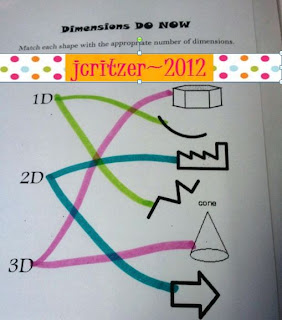
Also, before talking about specific formulas, I wanted the students to develop a general understanding for surface area and volume. My amazing PLC partner created a great discovery 'do now' activity that brought the students to the exact general understandings of these two terms through a series of scaffolded questions.
From there, we created this foldable. (not the most attractive, but they did the job)
{front}

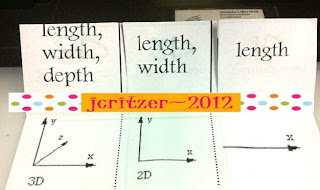
{inside of dimensions foldable}
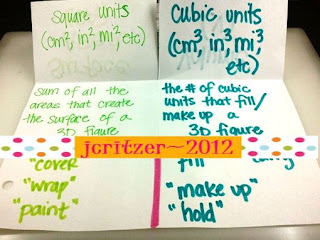
{inside of SA vs V foldable}
Sunday, March 18, 2012
foldables are like chocolate...
you can get addicted...be careful!
foldables have been my answer to everything here lately. i think i might need an intervention.
it all started years ago when i was introduced to them and i have to say, i've been a very sporadic foldable user since until about 2 months ago and now i just can't get enough.
i can barely go a day without using one.
like i said...i need an intervention.
since i've been using them so often, i figured i could use a place to document them, so here i am, starting another blog i more than likely won't keep up with, but whatever...story of my life!
foldables have been my answer to everything here lately. i think i might need an intervention.
it all started years ago when i was introduced to them and i have to say, i've been a very sporadic foldable user since until about 2 months ago and now i just can't get enough.
i can barely go a day without using one.
like i said...i need an intervention.
since i've been using them so often, i figured i could use a place to document them, so here i am, starting another blog i more than likely won't keep up with, but whatever...story of my life!
Subscribe to:
Comments (Atom)

